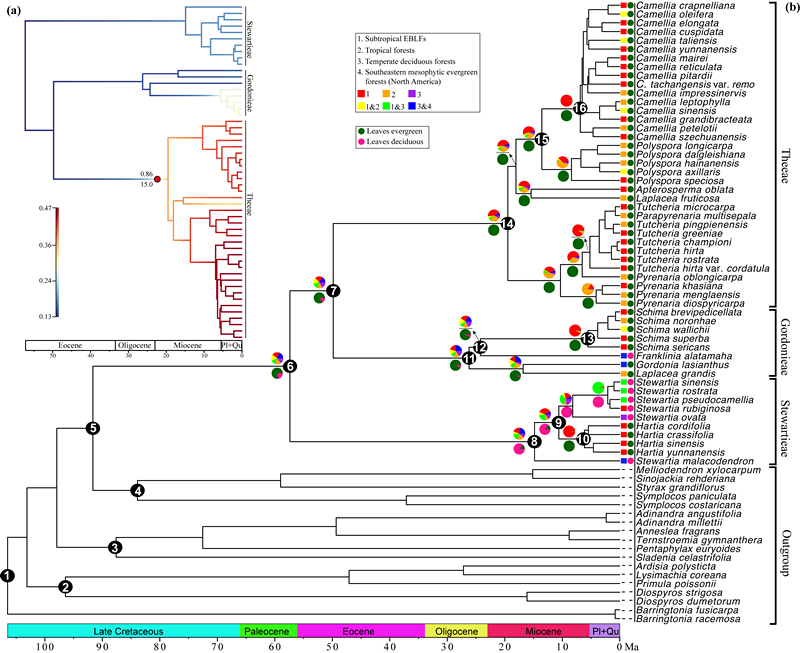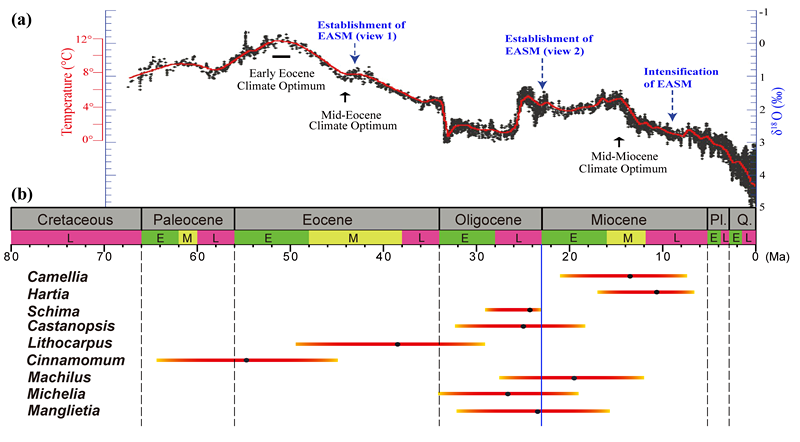The subtropical evergreen broadleaved forests (EBLFs), ranging in occurrence from c. 23° N to 39° N and 97° E to 141° E, are amongst the most characteristic biomes in East Asia and are common in South China. They contribute fundamentally to both the biodiversity function and ecosystem services of the East Asiatic floristic kingdom.
The East Asian subtropical EBLFs are considered as unique zonal vegetation that might have developed in concert with the Asian monsoons, particularly the summer monsoon that facilitates a humid climate. Although paleovegetation reconstructions have revealed that the subtropical EBLFs existed in Southwest China during the Miocene, the historical construction of the forests remains poorly known.
Prof. LI Dezhu’s group, together with Drs. GAO Lianming, YANG Junbo and YANG Shixiong from Kunming Institute of Botany, Chinese Academy of Sciences (KIB/CAS), Profs. Douglas E. Soltis and Pamela S. Soltis from University of Florida (USA) reconstructed the phylogenetic relationships and diversification dynamics of Theaceae based primarily on plastomes and nuclear ribosomal DNA sequences and fossil evidence.
The study revealed that combining the plastome and nrDNA data sets significantly improved the phylogenetic resolution within Theaceae, and the tribe Stewartieae was sister to the clade containing the tribe Theeae and the tribe Gordonieae. The recovered phylogenetic backbone was supported by the evolutionary pattern of the endosperm. Within Theeae, Camellia, Polyspora and Pyrenaria s.l., were suggested to form a monophyletic clade, and Camellia was sister to Polyspora.
As revealed by the current and earlier studies, most of the constructive elements (e.g. Schima of Theaceae, Castanopsis of Fagaceae, Machilus of Lauraceae, Michelia and Manglietia of Magnoliaceae) of the subtropical EBLFs appear to have originated around the Oligocene–Miocene (O–M) boundary. However, small woody lineages (e.g. Camellia, Hartia) from Theaceae were dated to the late Miocene. Accelerated net diversification rates within Theaceae were also detected near the O–M transition period and the late Miocene.
It is suggested that two independent intensifications of the East Asian summer monsoon (EASM) around the O–M boundary and the late Miocene may have facilitated the historical assembly of the subtropical EBLFs in East Asia.
This study entitled “Insights into the historical assembly of East Asian subtropical evergreen broadleaved forests revealed by the temporal history of the tea family” has been published in a top-journal in plant science, New Phytologist http://onlinelibrary.wiley.com/doi/10.1111/nph.14683/full.
In addition, the comparative chloroplast (cp) genomes of eleven Schima (Theaceae) species were also conducted, to gain insights into DNA barcoding and phylogeny. The results indicated that Schima cp genomes possess a typical quadripartite structure, with conserved genomic structure and gene order.
The size of the Schima cp genome was about 157 kilo base pairs (kb). They consistently encoded 114 unique genes, including 80 protein-coding genes, 30 tRNAs, and 4 rRNAs, with 17 duplicated in the inverted repeat (IR). These cp genomes were highly conserved and did not show obvious expansion or contraction of the IR region. The seven most widely touted DNA barcode regions as well as one potential barcode candidate showed low sequence divergence. However, other eight mutational hotspots were identified from the 11 cp genomes.
These hotspots may potentially be useful as specific DNA barcodes for species identification in Schima. Phylogenetic relationships among the 11 Schima species were resolved with strong support based on the cp genome data set, which corresponds well with the species distribution pattern.
This study entitled “Comparative chloroplast genomes of eleven Schima (Theaceae) species: Insights into DNA barcoding and phylogeny” was published in PLoS ONE http://journals.plos.org/plosone/article?id=10.1371/journal.pone.0178026.
The above two studies were funded by the National Key Basic Research Program of China (2014CB954100), the Strategic Priority Research Program of the Chinese Academy of Sciences (XDPB0201), the National Natural Science Foundation of China (31161140350, 31270246), the Applied Fundamental Research Foundation of Yunnan Province (2014FB167) and the China Postdoctoral Science Foundation (2014M562352).

Fig. 1 Phylogeny, divergence time, ancestral reconstruction of characters and speciation rates of Theaceae (Image by YU Xiangqin)

Fig. 2 Credibility intervals for the origins of the characteristic genera of East Asian subtropical evergreen broadleaved forests (EBLFs), three views referring to the initiation and intensification of the East Asian summer monsoon (EASM) are presented (Image by YU Xiangqin)
Contact:
Germplasm Bank of Wild Species
Kunming Institute of Botany, Chinese Academy of Sciences
Prof. LI De-Zhu
Email: dzl@mail.kib.ac.cn
(Editor:YANG Mei)




